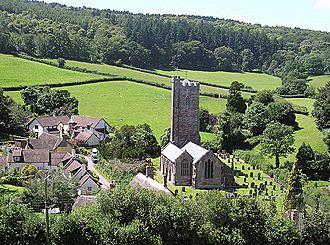St Mary's Church, Luccombe facts for kids
Quick facts for kids Church of St Mary |
|
|---|---|
 |
|
| General information | |
| Town or city | Luccombe |
| Country | England |
| Coordinates | 51°11′22″N 3°33′33″W / 51.1894°N 3.5593°W |
| Completed | c 1450 |
The Church of St Mary is a very old and beautiful church located in the village of Luccombe, England. It's a special building because it's been around for hundreds of years! Parts of the church, like the chancel (the area around the altar), were built way back in the 1300s. Other parts, like the main area (called the nave) and the tower, were added around 1450. This church is so important that it's officially recognized as a Grade I listed building, which means it's one of the most important historic buildings in the country.
The church was built by someone named John Maris. The oldest part, the chancel, dates back to about 1300. Later, in 1530, an extra section called an aisle was added. Between 1752 and 1756, a gallery was put in, but it was removed in 1840 when the church was updated and a vestry (a room for clergy and church items) was added.
Contents
The Church's Design and History
The Church of St Mary has a long and interesting history. Its first part, the chancel, was built around the year 1300. Imagine how old that is! The main part of the church, called the nave, and the tall tower were built about 150 years later, around 1450. Then, in 1530, another section, an aisle, was added to make the church bigger.
Changes Over the Years
Over the centuries, the church has seen many changes. In the mid-1700s, a gallery was built inside. However, this gallery was taken out in 1840 when the church was given a big update. At that time, a new room called the vestry was also added.
What the Church is Made Of
The church is mostly built from stone that has a rough coating on it. But some parts are different! The vestry is made of squared red sandstone, and the tower is built from random pieces of red sandstone. The roofs are covered with slate tiles.
Inside and Out
The church has a main area (the nave) and a south aisle, which is like a side section. It also has the chancel, a vestry, a porch at the north entrance, and a tall tower on the west side.
The tower is built in three sections and has a decorative top with crenellations, which look like the battlements on a castle. You can also spot gargoyles on the tower, which are stone carvings that often look like monsters and help drain water away. The tower doesn't have buttresses (supports), but it does have decorative stone bands called string courses.
Inside the tower, there are six bells! Five of these bells were made way back in 1759. The inside of the church is painted white, and the roof looks like a barrel, curving upwards. The arch leading to the tower is pointed, in a style called Perpendicular.
Special Features Inside
When you go inside, you'll see some very old and special items. There's a pulpit (where the preacher stands) and a chair from the Jacobean period, which was in the early 1600s. There's also a medieval rood screen, which is a decorative screen that used to separate the chancel from the nave.
More About the Church
The Church of St Mary is part of a group of churches in the area, including those in Porlock, Porlock Weir, Stoke Pero, and Selworthy. It's all part of the larger church organization in the region.
See also
- Grade I listed buildings in West Somerset
- List of Somerset towers
- List of ecclesiastical parishes in the Diocese of Bath and Wells

